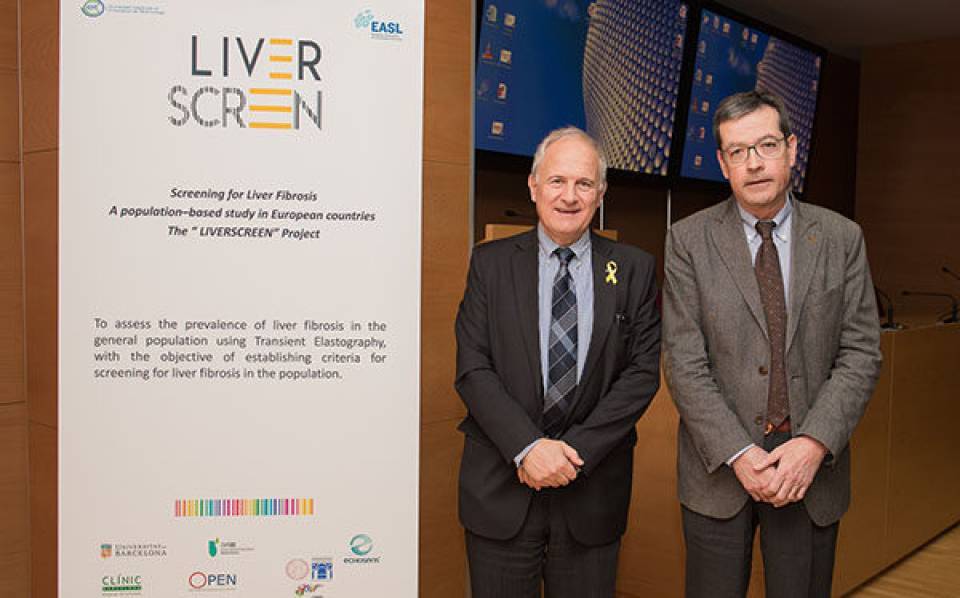The study was coordinated by Dr. Pere Ginés, Head of the Hepatology Department at Hospital Clínic and Head of the IDIBAPS team Mechanisms of liver diseases and complications of cirrhosis, and Dr. Llorenç Caballeria, Primary Care Physician of the USR Metropolitana Nord-IDIAP Jordi Gol.
Chronic liver diseases, especially cirrhosis and liver cancer, are a frequent cause of death worldwide. These diseases evolve slowly and silently for many years without being diagnosed since they produce no symptoms until they are in very advanced stages. At this point, the only curative treatment is liver transplantation. Although cirrhosis caused by the hepatitis C virus is decreasing all over the world thanks to the use of new antiviral drugs, the prevalence of cirrhosis due to alcohol consumption and, above all, non-alcoholic fatty liver disease, is increasing worldwide.
Non-alcoholic fatty liver disease is associated with metabolic disorders, such as obesity or type 2 diabetes, and affects approximately 25% of the world population. However, only a small proportion of patients with non-alcoholic fatty liver develop cirrhosis and the main prediction factor is liver fibrosis. "Knowing the degree of liver fibrosis in general population will be useful to design screening strategies that will allow us to early diagnose liver disease with risk of progression. Thus, therapeutic interventions could be applied before the onset of cirrhosis." explains Pere Ginés, who is also full professor at the Faculty of Medicine and Health Sciences of the University of Barcelona.
In the study, published in the Clinical Gastroenterology and Hepatology journal, 3,076 people aged between 18 and 75 years from the metropolitan area of Barcelona have participated. They underwent hepatic elastography, a non-invasive method to determine the stiffness of the liver. With this test, researchers detected that 3.6% of the participants had an undiagnosed chronic liver disease with advanced fibrosis with a high risk of progressing to cirrhosis or cancer. The 58% of them had risk factors for chronic liver disease, most of them metabolic, such as obesity or diabetes, and to a lesser extent, excessive alcohol consumption.
Researchers point out that if this proportion is extrapolated to the entire Catalan population, 150,000 people in Catalonia, between 18 and 75 years, could have an undiagnosed advanced chronic liver disease.
"The use of elastography allows us to distinguish which of the patients with risk factors have advanced liver fibrosis," explains Llorenç Caballeria. "This early detection allows us to refer patients to referral hospitals to decipher which is disease affecting them and its origin," he adds.
"The screening of liver diseases already in primary care would facilitate the application of measures to prevent the progression of chronic liver disease and, therefore, could contribute to the reduction of mortality from this cause," concludes Pere Ginés.
A European study with 20,000 participants
Based on the results obtained in this study, researchers have launched the LIVERSCREEN project with funds from the European agency EIT Health. It is coordinated by the Hepatology Department at Hospital Clínic and it is a larger study to confirm the results in a greater number of people and countries. The potential of hepatic elastography in the screening of chronic liver disease in the general population will also be determined.
The aim is to include 20,000 people from all over Europe and centers form Barcelona, Italy, Holland, Denmark, France, Germany and the United Kingdom participate in the project.
Article reference:
High Prevalence of Liver Fibrosis Among European Adults with Unknown Liver Disease. A Population-Based Study Caballería L, Pera G, Arteaga I, Rodríguez L, Alumà A, Morillas RM, de la Ossa N, Díaz A, Expósito C, Miranda D, Sánchez C, Prats RM, Urquizu M, Salgado A, Alemany M, Martinez A, Majeed I, Fabrellas N, Graupera I, Planas R, Ojanguren I, Serra M, Torán P, Caballería J, Ginès P. Clin Gastroenterol Hepatol. 2018 Feb 13. pii: S1542-3565(18)30006-5. doi: 10.1016/j.cgh.2017.12.048.

